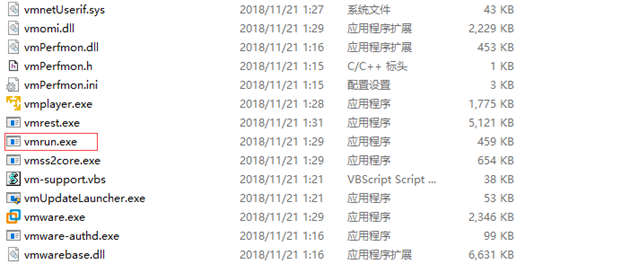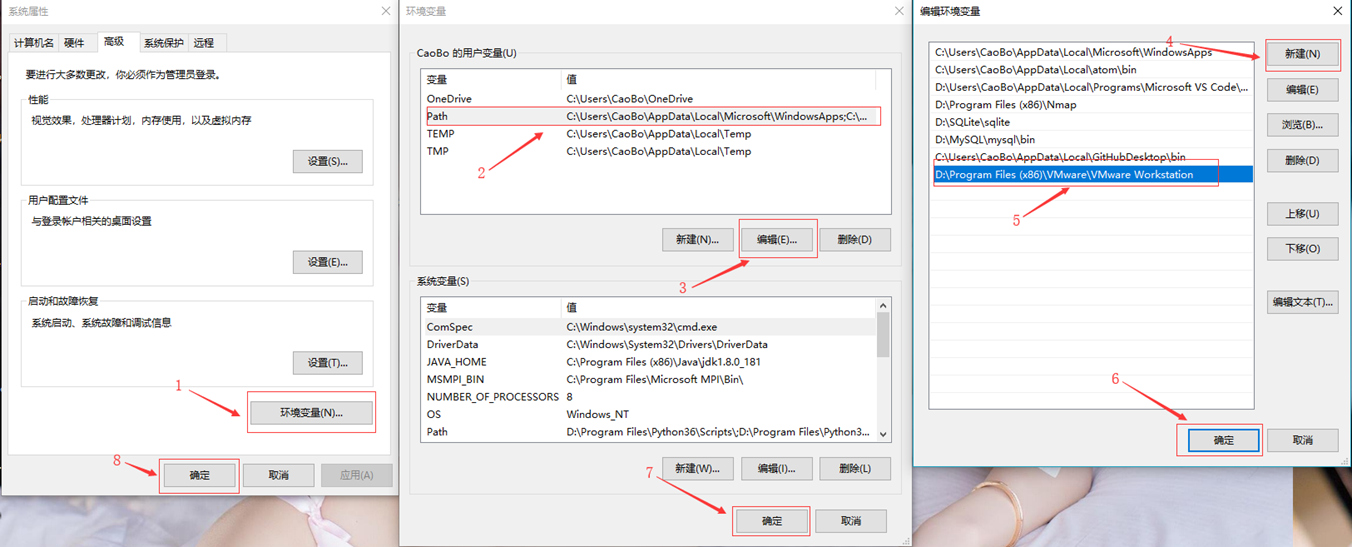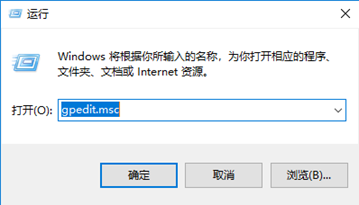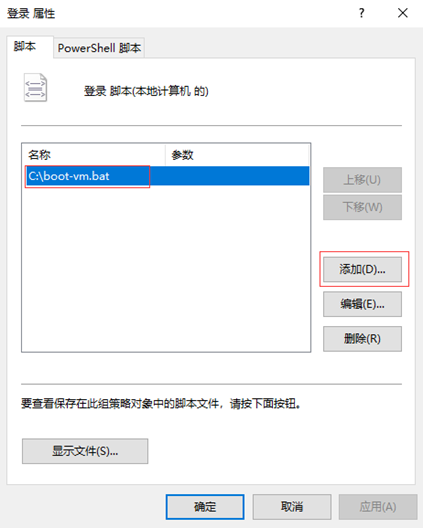日常工作中,由於條件以及成本的限制,我們會在自己本地電腦上安裝虛擬機裝服務器系統,來滿足自己工作中對服務器的需求,但是很多時候,我們自己的電腦關機或者重啓後,虛擬機並不會自行啓動,需要我們手動啓動虛擬機,如果我們只有一兩臺虛擬機,那沒什麼,啓動很快,但是,如果我們有很多臺虛擬機呢?10 臺,20 臺,甚至更多,難道我們還要手動一個個開機嗎?那真是太讓人頭疼,又太浪費時間。下面,我們就講下,如何讓虛擬機在我們自己的主機開機時自動啓動。
一、VMware workstation 虛擬機開機自啓動的原理
要說 VMware workstation 虛擬機開機自啓動,在 VMware workstation 圖形界面是找不到設置方法的,但是圖形界面找不到設置方法,不代表它就沒有設置方法。
要設置開機自啓動,首先,我們得了解下 VMware workstation 所提供的命令行工具 vmrun 。
1、我們進入到 VMware workstation 的安裝目錄,找一下 vmrun.exe 文件,如下圖,正式這個工具,爲我們提供了虛擬機的自啓動方法。
2、將 VMware workstation 的安裝目錄添加到系統的環境變量,如下圖,按照途中的順序,依次操作即可
注意:在第 5 步時,需要找到自己的 VMware workstation 的安裝目錄,然後添加到這裏。
3、在 DOS 界面中查看 vmrun 命令的語法格式及參數
Microsoft Windows [版本 10.0.17134.471] (c) 2018 Microsoft Corporation。保留所有權利。 C:\Users\CaoBo>vmrun vmrun version 1.17.0 build-10952284 Usage: vmrun [AUTHENTICATION-FLAGS] COMMAND [PARAMETERS] AUTHENTICATION-FLAGS -------------------- These must appear before the command and any command parameters. -T <hostType> (ws|fusion||player) -vp <password for encrypted virtual machine> -gu <userName in guest OS> -gp <password in guest OS> POWER COMMANDS PARAMETERS DESCRIPTION -------------- ---------- ----------- start Path to vmx file Start a VM or Team [gui|nogui] stop Path to vmx file Stop a VM or Team [hard|soft] reset Path to vmx file Reset a VM or Team [hard|soft] suspend Path to vmx file Suspend a VM or Team [hard|soft] pause Path to vmx file Pause a VM unpause Path to vmx file Unpause a VM SNAPSHOT COMMANDS PARAMETERS DESCRIPTION ----------------- ---------- ----------- listSnapshots Path to vmx file List all snapshots in a VM [showTree] snapshot Path to vmx file Create a snapshot of a VM Snapshot name deleteSnapshot Path to vmx file Remove a snapshot from a VM Snapshot name [andDeleteChildren] revertToSnapshot Path to vmx file Set VM state to a snapshot Snapshot name GUEST OS COMMANDS PARAMETERS DESCRIPTION ----------------- ---------- ----------- runProgramInGuest Path to vmx file Run a program in Guest OS [-noWait] [-activeWindow] [-interactive] Complete-Path-To-Program [Program arguments] fileExistsInGuest Path to vmx file Check if a file exists in Guest OS Path to file in guest directoryExistsInGuest Path to vmx file Check if a directory exists in Guest OS Path to directory in guest setSharedFolderState Path to vmx file Modify a Host-Guest shared folder Share name Host path writable | readonly addSharedFolder Path to vmx file Add a Host-Guest shared folder Share name New host path removeSharedFolder Path to vmx file Remove a Host-Guest shared folder Share name enableSharedFolders Path to vmx file Enable shared folders in Guest [runtime] disableSharedFolders Path to vmx file Disable shared folders in Guest [runtime] listProcessesInGuest Path to vmx file List running processes in Guest OS killProcessInGuest Path to vmx file Kill a process in Guest OS process id runScriptInGuest Path to vmx file Run a script in Guest OS [-noWait] [-activeWindow] [-interactive] Interpreter path Script text deleteFileInGuest Path to vmx file Delete a file in Guest OS Path in guest createDirectoryInGuest Path to vmx file Create a directory in Guest OS Directory path in guest deleteDirectoryInGuest Path to vmx file Delete a directory in Guest OS Directory path in guest CreateTempfileInGuest Path to vmx file Create a temporary file in Guest OS listDirectoryInGuest Path to vmx file List a directory in Guest OS Directory path in guest CopyFileFromHostToGuest Path to vmx file Copy a file from host OS to guest OS Path on host Path in guest CopyFileFromGuestToHost Path to vmx file Copy a file from guest OS to host OS Path in guest Path on host renameFileInGuest Path to vmx file Rename a file in Guest OS Original name New name typeKeystrokesInGuest Path to vmx file Type Keystrokes in Guest OS keystroke string connectNamedDevice Path to vmx file Connect the named device in the Guest OS device name disconnectNamedDevice Path to vmx file Disconnect the named device in the Guest OS device name captureScreen Path to vmx file Capture the screen of the VM to a local file Path on host writeVariable Path to vmx file Write a variable in the VM state [runtimeConfig|guestEnv|guestVar] variable name variable value readVariable Path to vmx file Read a variable in the VM state [runtimeConfig|guestEnv|guestVar] variable name getGuestIPAddress Path to vmx file Gets the IP address of the guest [-wait] GENERAL COMMANDS PARAMETERS DESCRIPTION ---------------- ---------- ----------- list List all running VMs upgradevm Path to vmx file Upgrade VM file format, virtual hw installTools Path to vmx file Install Tools in Guest checkToolsState Path to vmx file Check the current Tools state deleteVM Path to vmx file Delete a VM clone Path to vmx file Create a copy of the VM Path to destination vmx file full|linked [-snapshot=Snapshot Name] [-cloneName=Name] Template VM COMMANDS PARAMETERS DESCRIPTION --------------------- ---------- ----------- downloadPhotonVM Path for new VM Download Photon VM Examples: Starting a virtual machine with Workstation on a Windows host vmrun -T ws start "c:\my VMs\myVM.vmx" Running a program in a virtual machine with Workstation on a Windows host with Windows guest vmrun -T ws -gu guestUser -gp guestPassword runProgramInGuest "c:\my VMs\myVM.vmx" "c:\Program Files\myProgram.exe" Creating a snapshot of a virtual machine with Workstation on a Windows host vmrun -T ws snapshot "c:\my VMs\myVM.vmx" mySnapshot Reverting to a snapshot with Workstation on a Windows host vmrun -T ws revertToSnapshot "c:\my VMs\myVM.vmx" mySnapshot Deleting a snapshot with Workstation on a Windows host vmrun -T ws deleteSnapshot "c:\my VMs\myVM.vmx" mySnapshot Enabling Shared Folders with Workstation on a Windows host vmrun -T ws enableSharedFolders "c:\my VMs\myVM.vmx"
①、驗證標誌(AUTHENTICATION-FLAGS):
-T 代表目標類型,ws 表示工作站(即 Workstation ),一般使用此參數即可,其他很少使用,就不做解釋了。當然還有 server、esx、vc 等等,這裏沒有列出。
②、電源指令(POWER COMMANDS):
start:開啓虛擬機
stop:關閉虛擬機
reset:重置虛擬機
suspend:掛起虛擬機
③、快照指令(SNAPSHOT COMMANDS):
listSnapshots:列出虛擬機的快照數量及名稱
snapshot:爲虛擬機創建快照
deleteSnapshot:刪除虛擬機的快照
revertToSnapshot:從一個快照恢復虛擬機
④、常用命令(GENERAL COMMANDS):
list:列出正在運行的虛擬機的數量及名稱
upgradevm:升級虛擬機的文件格式,虛擬硬件
installTools:在 Guest 中安裝工具
checkToolsState:檢查工具狀態
deleteVM:刪除一個虛擬機
clone:克隆虛擬機
這裏只介紹這麼多命令,其他的命令很少用到,就不多做解釋。
言歸正傳,我們要設置虛擬機開機自啓動,就要使用上面 start 命令。那麼,此命令如何使用呢,格式時這樣的:
vmrun -T ws start "c:\my VMs\myVM.vmx"
"c:\my VMs\myVM.vmx" 該目錄爲虛擬機的工作目錄
我們可以在這條命令後面加上 nogui ,表示無圖形界面啓動,而默認的啓動模式是 gui 模式,即有圖形界面啓動。
vmrun -T ws start "c:\my VMs\myVM.vmx" nogui
最後,我們將該命令修改爲自己的虛擬機工作目錄後寫到批處理文件中(如下圖),添加開機啓動腳本或者計劃任務。
二、Windows 中設置虛擬機開機自啓動
在 Windows 中設置虛擬機開機自啓動又兩種辦法
①、用計劃任務來實現。
創建計劃任務:
如圖,我們將計劃任務的設置爲使用最高權限運行,觸發器設置爲在系統啓動時觸發,而操作是啓動批處理腳本。
計劃任務創建完成後,我們可以將自己的主機重啓,看看我們的虛擬機是否有自動開機。
②、用組策略來實現
在 <運行> 中輸入 gpedit.msc 打開組策略,如下圖
在組策略中,依次選擇 <用戶配置> <Windows 設置> <腳本(登陸/註銷)>,雙擊 <登陸>,如下圖
在 <登陸 屬性> 對話框中添加我們之前寫好的啓動腳本即可,如下圖
設置完之後,我們重啓主機,再看看虛擬機有沒有啓動。
三、總結
在日常工作中,我們解決問題的辦法可能不止一種,但往往由於我們所學知識的侷限性性,導致我們的思路會很單一,因此,我們就要通過不斷的學習,來拓寬我們視界,才能更好的提高我們的深獲質量。









